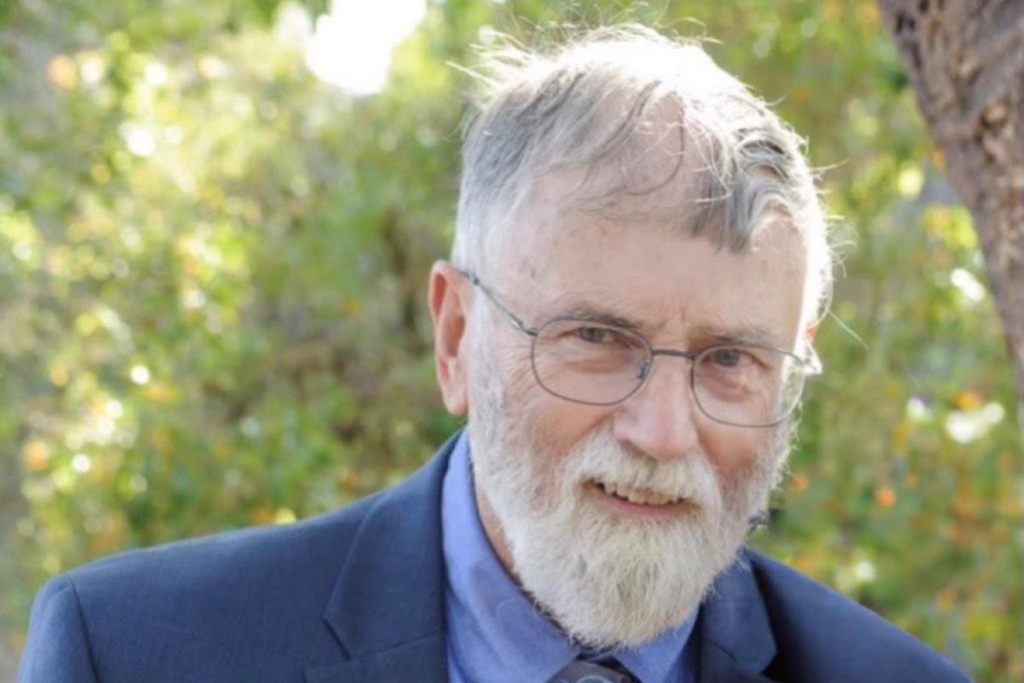John Charles Campbell died peacefully in the early morning on the day a rare snow fell. He left quietly, his breathing barely audible, his body weak, his spirit strong, on his face an expression of awestruck wonder. For days in the hushed room, family kept vigil, witnessing his passing with love and gratitude for his well-lived life.
John was a physicist, and his work involved testing the earliest of the Earth-viewing satellites. Endowed with a deep love of nature and reverence for life, John was tall, broad-shouldered, kind, and shy, with sparkling, clear blue eyes. He possessed spacious intelligence and a subtle sense of humor.
John was born on November 30, 1937, in Lincoln, Nebraska to Fred C. Campbell and Lois E. Cordner née Campbell. Their home was built by his architect grandfather. Dust Bowl refugees, they left the drought-stricken family farm for California, landing in Altadena, then Palos Verdes. As a boy, John would hitchhike to the Santa Monica pier to fish all day. An early scientist, he and a friend built crystal radios and made telephones connecting their houses.
When John was 12, his family moved to Hood River, Oregon, where his parents owned the Lone Pine Motel. John was the tallest boy and fastest runner in his school. He loved to roam the woods and streams hunting, fishing, and exploring nature. Catching a sturgeon in the Columbia River so huge it made the newspaper was a highlight of his boyhood.
In high school he lettered in track and turned out for football and basketball. He was set to run in the Junior Olympics, but this dream was dashed when he contracted polio. After months in the hospital, almost completely paralyzed, he made an amazing recovery. He returned to school and graduated as salutatorian.
John went to Linfield College with a scholarship, joining the Theta Chi fraternity. In the spring he asked a girl, Pat “Anna” Butler, to the Theta Chi beach party. Their space-time continuums began to intertwine. He invited her to climb Cooper’s Spur on Mt. Hood with him, and they became best friends.
On June 23, 1962, they were married in Seattle where John was an engineer at Boeing. Then John was selected as a Rockefeller Fellow in a program to build understanding between scientists and theologians. He and his wife moved to New York City to attend Union Theological Seminary. Based in New York, John worked as a trail guide in the Adirondacks and was co-leader of an International Youth Peace Seminar in Bavaria sponsored by the World Council of Churches. His thesis was on ethics in white collar organizations. In 1965 he graduated with a master’s in divinity.
The couple moved to Amherst where he earned his master’s in physics at the University of Massachusetts. After their first daughter, Heather, was born, John was hired by Santa Barbara Research Center (SBRC), and they settled in Santa Barbara where daughter Danae Michele and son Charles Skye were born.
At SBRC John worked with Jim Young, head of Optics, technician Jim Shields, and others, calibrating and testing the VISSR (visible infrared spin scan radiometers) systems for the early weather satellites, and the Thematic Mapper and MSS (multi-spectral scanner), which was the pioneering optical system for the Landsat. John worked full-time at SBRC for 25 years, from 1969 to 1994, and was asked to come back on contract for another 10 years.
The first Landsat was launched in 1972. John tested the optics for the first seven Landsats. The 50th anniversary of that first launch, held in September 2022 at Vandenburg Space Force Base, was attended by U.S. Secretary of the Interior Deb Haaland. She stated that the Landsat was the single best resource the world has to understand climate change because of its spectacular 50-year daily record of changes on the whole earth, a priceless legacy. The Landsats performed with excellence and longevity beyond expectations, a tribute to the careful work of the Optics team and others. John also worked in missions to explore the oceans for the NOAA (National Oceanic and Atmospheric Administration), the earth for the EOS (Earth Observing System), and the GOES and GM weather satellites. John’s friends and colleagues at SBRC worked on other fascinating missions, such as the Pioneer and Viking interplanetary voyages of exploration.
John loved to travel, taking his family on adventurous vacations, notably a six-week camping trip in Europe. After retirement, he and Anna continued their earth explorations, traveling to 33 countries and high places such as Tiger’s Nest in Bhutan, Tibet’s Kumba La, Peru’s Machu Picchu, and the Cuillins on the Isle of Skye.
John is survived by wife Anna; daughter Heather and her husband Bernard Unterman; daughter Danae and her husband Ron Liechti; grandchildren Koi (Kaila), Cappy, Sarah, and Lincoln; brother Joe; and many friends and family. He was predeceased by his son Skye, his parents, and brother Dan.
John’s memorial will be Sunday, May 21, at 2:30, at Trinity Episcopal, 1500 State Street, with a reception celebrating his life and work. All are welcome. His color was blue, so you may wish to wear blue. Gifts in his memory may be made to Direct Relief. The service will be live-streamed at https://us06web.zoom.us/j/86427996483 (ID 864 2799 6483).

